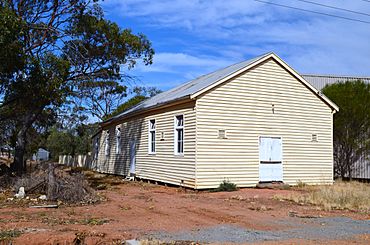Coomberdale, Western Australia facts for kids
Quick facts for kids CoomberdaleWestern Australia |
|
|---|---|

Coomberdale Hall, 2014.
|
|
| Established | 1895 |
| Postcode(s) | 6512 |
| Elevation | 220 m (722 ft) |
| Area | [convert: needs a number] |
| Location | |
| LGA(s) | Shire of Moora |
| State electorate(s) | Moore |
| Federal Division(s) | Durack |
Coomberdale is a small and quiet town in Western Australia. It's located in a farming area called the Wheatbelt region. You can find it along the Midlands Road, which connects the towns of Moora and Watheroo. In 2021, only 56 people lived there, making it a very small community.
Contents
Discovering Coomberdale
Where is Coomberdale?
Coomberdale is about 194 kilometers (120 miles) north of Perth, the capital city of Western Australia. It's also just 20 kilometers (12 miles) north of the larger town of Moora.
How Coomberdale Started
The town began because of the railway. In 1895, a company called the Midland Railway Company built a special stop for trains here. This was when the Midland railway line was opened, connecting places all the way to Walkaway.
The name "Coomberdale" comes from a well. An explorer named Alexander Forrest found and named this well. He was surveying land for Edmund King, who settled in the area in 1866.
The Coomberdale Hall
The Coomberdale Hall is an important building in the town. It was built around 1920. It's made of timber with weatherboard walls and a corrugated iron roof. Today, this hall is considered a heritage building, meaning it's historically important. It's used as part of the nearby community center.
What People Do in Coomberdale
The main job in Coomberdale is wheat farming. Farmers grow a lot of wheat in this area. The town has a special place called a CBH Group receival site. This is where farmers bring their harvested wheat to be stored and sent away.
There is also a company called Simcoa that produces silicon. They have a quartz mine close to Coomberdale. The special rock they mine there is called Coomberdale chert. This rock is found in a unique natural area. This area is home to some rare plants, like Acacia aristulata and Cryptandra glabiflora.


